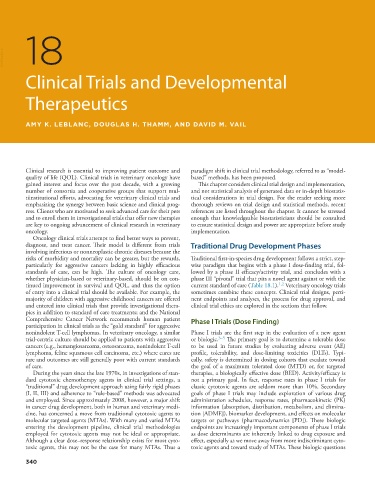Page 362 - Withrow and MacEwen's Small Animal Clinical Oncology, 6th Edition
P. 362
18
VetBooks.ir
Clinical Trials and Developmental
Therapeutics
AMY K. LEBLANC, DOUGLAS H. THAMM, AND DAVID M. VAIL
Clinical research is essential to improving patient outcome and paradigm shift in clinical trial methodology, referred to as “model-
quality of life (QOL). Clinical trials in veterinary oncology have based” methods, has been proposed.
gained interest and focus over the past decade, with a growing This chapter considers clinical trial design and implementation,
number of consortia and cooperative groups that support mul- and not statistical analysis of generated data or in-depth biostatis-
tiinstitutional efforts, advocating for veterinary clinical trials and tical considerations in trial design. For the reader seeking more
emphasizing the synergy between basic science and clinical prog- thorough reviews on trial design and statistical methods, recent
ress. Clients who are motivated to seek advanced care for their pets references are listed throughout the chapter. It cannot be stressed
and to enroll them in investigational trials that offer new therapies enough that knowledgeable biostatisticians should be consulted
are key to ongoing advancement of clinical research in veterinary to ensure statistical design and power are appropriate before study
oncology. implementation.
Oncology clinical trials attempt to find better ways to prevent,
diagnose, and treat cancer. Their model is different from trials Traditional Drug Development Phases
involving infectious or nonneoplastic chronic diseases because the
risks of morbidity and mortality can be greater, but the rewards, Traditional first-in-species drug development follows a strict, step-
particularly for aggressive cancers lacking in highly efficacious wise paradigm that begins with a phase I dose-finding trial, fol-
standards of care, can be high. The culture of oncology care, lowed by a phase II efficacy/activity trial, and concludes with a
whether physician-based or veterinary-based, should be on con- phase III “pivotal” trial that pits a novel agent against or with the
1,2
tinued improvement in survival and QOL, and thus the option current standard of care (Table 18.1). Veterinary oncology trials
of entry into a clinical trial should be available. For example, the sometimes combine these concepts. Clinical trial designs, perti-
majority of children with aggressive childhood cancers are offered nent endpoints and analyses, the process for drug approval, and
and entered into clinical trials that provide investigational thera- clinical trial ethics are explored in the sections that follow.
pies in addition to standard of care treatments; and the National
Comprehensive Cancer Network recommends human patient Phase I Trials (Dose Finding)
participation in clinical trials as the “gold standard” for aggressive
nonindolent T-cell lymphomas. In veterinary oncology, a similar Phase I trials are the first step in the evaluation of a new agent
trial-centric culture should be applied to patients with aggressive or biologic. 3–5 The primary goal is to determine a tolerable dose
cancers (e.g., hemangiosarcoma, osteosarcoma, nonindolent T-cell to be used in future studies by evaluating adverse event (AE)
lymphoma, feline squamous cell carcinoma, etc.) where cures are profile, tolerability, and dose-limiting toxicities (DLTs). Typi-
rare and outcomes are still generally poor with current standards cally, safety is determined in dosing cohorts that escalate toward
of care. the goal of a maximum tolerated dose (MTD) or, for targeted
During the years since the late 1970s, in investigations of stan- therapies, a biologically effective dose (BED). Activity/efficacy is
dard cytotoxic chemotherapy agents in clinical trial settings, a not a primary goal. In fact, response rates in phase I trials for
“traditional” drug development approach using fairly rigid phases classic cytotoxic agents are seldom more than 10%. Secondary
(I, II, III) and adherence to “rule-based” methods was advocated goals of phase I trials may include exploration of various drug
and employed. Since approximately 2008, however, a major shift administration schedules, response rates, pharmacokinetic (PK)
in cancer drug development, both in human and veterinary medi- information (absorption, distribution, metabolism, and elimina-
cine, has concerned a move from traditional cytotoxic agents to tion [ADME]), biomarker development, and effects on molecular
molecular targeted agents (MTAs). With many and varied MTAs targets or pathways (pharmacodynamics [PD]). These biologic
entering the development pipeline, clinical trial methodologies endpoints are increasingly important components of phase I trials
employed for cytotoxic agents may not be ideal or appropriate. as dose determinants are inherently linked to drug exposure and
Although a clear dose–response relationship exists for most cyto- effect, especially as we move away from more indiscriminant cyto-
toxic agents, this may not be the case for many MTAs. Thus a toxic agents and toward study of MTAs. These biologic questions
340

